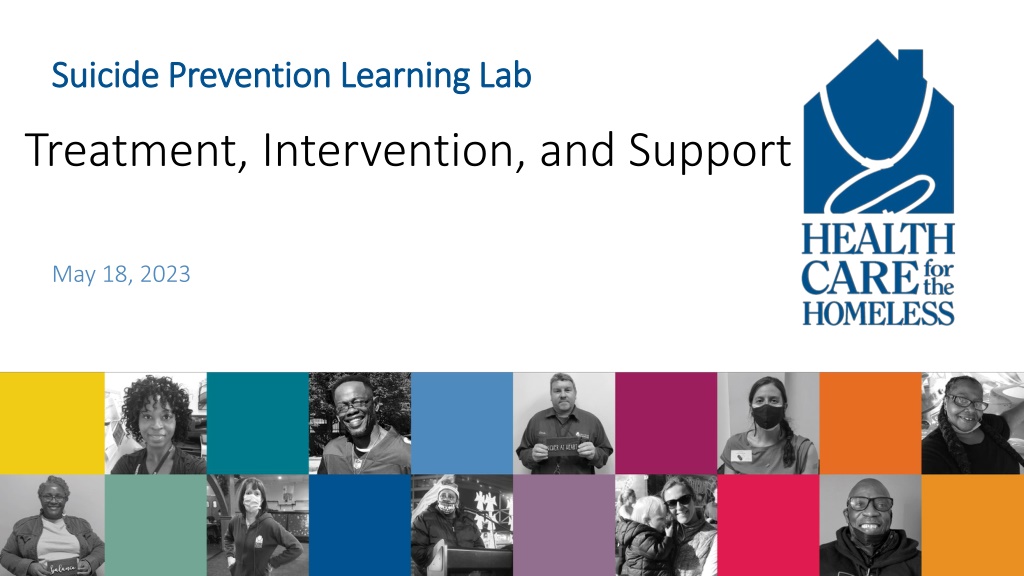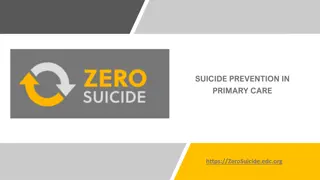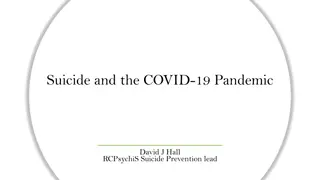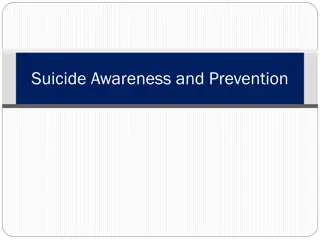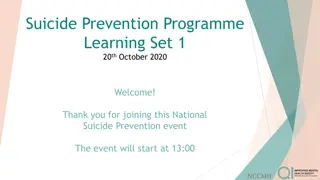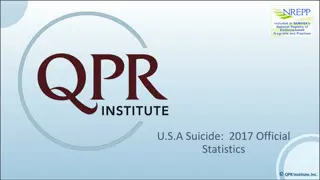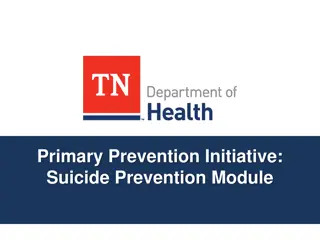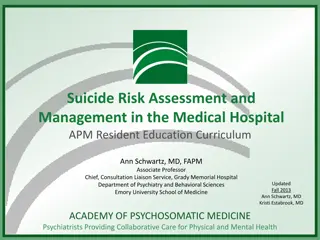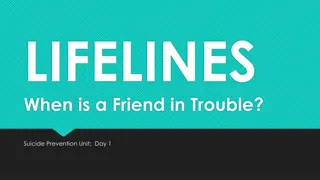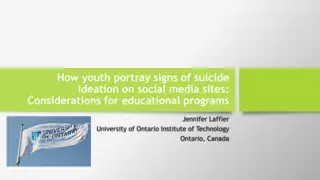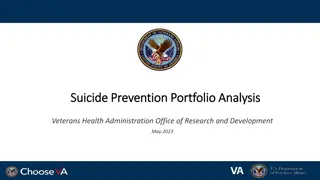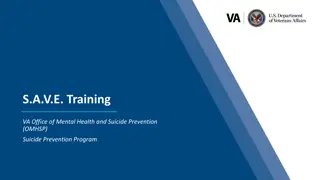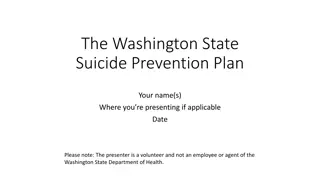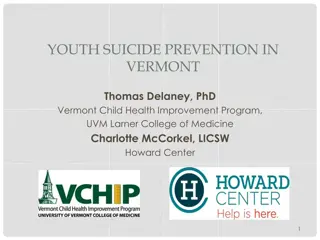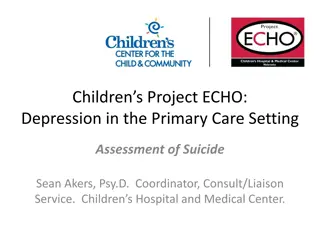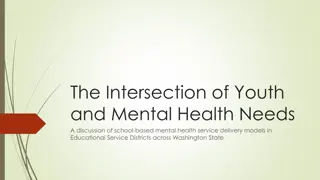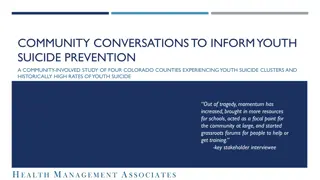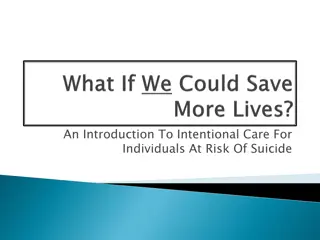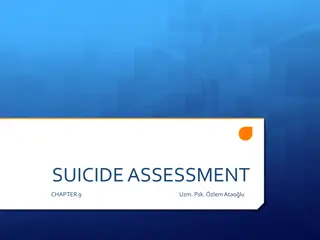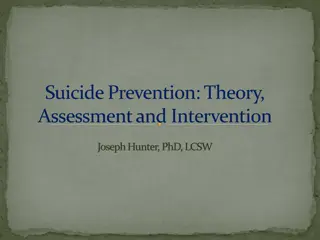Cultural Considerations in Suicide Prevention: Insights and Interventions
Explore cultural perspectives on suicide and the importance of culturally responsive interventions, with a focus on indigenous communities and African American populations. Learn about challenging assumptions, new possibilities, and best practices for supporting individuals at risk of suicide while respecting their cultural backgrounds.
- Cultural considerations
- Suicide prevention
- Culturally responsive interventions
- Indigenous communities
- African American
Download Presentation

Please find below an Image/Link to download the presentation.
The content on the website is provided AS IS for your information and personal use only. It may not be sold, licensed, or shared on other websites without obtaining consent from the author. Download presentation by click this link. If you encounter any issues during the download, it is possible that the publisher has removed the file from their server.
E N D
Presentation Transcript
Suicide Prevention Learning Lab Suicide Prevention Learning Lab Treatment, Intervention, and Support May 18, 2023
Learning Objectives 1. Cultural Perspectives on Suicide 2. Treatment Planning 3. Common Interventions 4. Supporting clients after a suicide attempt 5. Supporting providers as they support others
Cultural Perspectives on Suicide Cultural Perspectives on Suicide
Cultural Perspectives The call upon clinicians to provide culturally responsive interventions is higher than ever before. Understandings of suicide are often influenced by culture Oppression, racial trauma, displacement and perfectionism as an influencer of suicidal behaviors is not always well understood Suicide may not be viewed as taboo in all cultures This is particularly true within cultures where family honor is highly regarded and centered as more important that individual needs
Cultural Considerations Indigenous Communities Unexamined Assumptions Suicide expresses underlying psychological problems New Possibilities Suicide expresses historical, cultural, community and family disruptions Suicide is primarily an agentic expression of personal volition Suicide is primarily an enacted consequence of social obligation Suicide prevention is best achieved by mental health professionals Suicide prevention is best achieved by nonprofessional community members Suicide prevention most properly falls within the purview of formal mental health service delivery systems Suicide prevention most properly falls within the purview of locally design decolonization projects
Culturally Responsive Interventions African American Communities Reluctance to seek help is valid, and spending the time to explore it is critical. Use words that are non-pathologizing, i.e. counseling vs. therapy . The latter seems more serious and more commonly associated with being crazy . If psychotropic drugs are indicated, it helps to compare the medication to those used for diabetes or high blood pressure. Talk about medications as a means to stabilize, rather than treat. Engage spiritual supports and fictive kin in care and treatment planning.
Treatment Planning Treatment Planning
Developing a Treatment Plan Managing our own emotional responses to suicidal ideations Establishing a therapeutic alliance Honoring and centering lived experience SMART Goals
SMART Goals Specific The goal should be based on exactly what they wish to accomplish Measurable The goal can be monitored for progress, through smaller tasks leading to completion, due dates or collecting data Attainable The goal should not be so challenging that it is impossible to achieve Relevant The goal should be appropriate for the individual and the situation Timely The goal should have clear time limits that are realistic
SMART Goal Examples Kelly will engage in learning more about her depression by completing homework assignments 1-2 times per week over the next 30 days. Sam will download the free Mood Tracker app by next therapy session on 6/1/2023. Dana will attend group therapy session 3-4 times per month over the next 3 months in order to build community and decrease shame that leads to suicidal thoughts.
Interventions Interventions
Common Interventions Brief Interventions Safety Planning Intervention Lethal Means Counseling Emergency Petitions Warm Hand-Offs
Safety Planning Intervention (SPI) Developed by Drs. Barbara Stanley and Gregory Brown and centers collaboration between an individual and a mental health care provider. The Safety Plan is personal, unique and includes the client s identification of the thoughts, feelings and experiences just prior to decompensation that they can learn may signal an impending suicidal crisis . It also identifies actions they have found helpful at earlier times of distress in their life.
Lethal Means Counseling (LMC) Means reduction (reducing a suicidal person s access to highly lethal means) is an important part of a comprehensive approach to suicide prevention. The basic goal of LMC is to reduce risk of suicide by engaging the individual and/or family in securing and reducing access to every form of lethal means possible. A suicidal crisis can escalate quickly and the time between the decision to end one s life and taking action is often brief. If a person does not have access to lethal means they will not die from self- harm behavior.
Lethal Means Counseling (LMC) Lethal Means Counseling involves these steps: Express concern for safety Let them know what they can do to create a safe environment Remove or secure any type of lethal means from the home (or work) environment This can include items such as firearms, medications (prescribed and over-the- counter), toxic substances like cleaning supplies, sharp objects Explain how lethal means safety works Can t predict crises During moments of acute risk, need to reduce access to lethal means they have focused on People usually don t switch quickly to a different method since thinking is less flexible in that moment If attempt does occur, other methods are likely to be less lethal
The Power of the Warm Hand-Off Providers have enormous influence on how a client will perceive and respond to the offer of behavioral health intervention. With a warm hand-off, the provider directly introduces the client to behavioral health resource at the time of need. The warm hand-off is most powerful when done face-to-face. It establishes initial contact between the client and referral source and confers the trust and rapport the client has developed with the provider to the referral source.
Warm Hand-Off Guidelines Know your referral sources in advance Approach the client with your concerns Follow your agency s procedure for making the referral Follow up with the referral source to determine outcome Follow up with the client within 48 hours of referral
Care After a Suicide Attempt Care After a Suicide Attempt
Care Transitions Inpatient psychiatric care is designed to mitigate immediate risk, begin treatment, and prepare individuals for continuing care after hospitalization. Hospitalization is not intended to be the only care a person requires to return to a state of wellness. The first week after discharge from inpatient treatment carries extraordinary risk for suicide, with suicide deaths occurring during this week at a rate 300 times higher than the global suicide rate (Chung et al., 2019). The transition from inpatient to outpatient care represents a tremendous gap in the health care delivery systems and is challenging to close for myriad reasons.
Care Transitions-Best Practices Considerations for Inpatient Providers: Begin discharge planning upon admission, preferably within 24 hour Develop collaborative protocols Electronically deliver copies of essential records to aid the outpatient provider post- discharge Encourage family participation, keeping in mind that family is self-defined Include Peer Specialist whenever possible Engage community supports Collaboratively develop a safety plan and offer a discharge planning meeting Schedule an outpatient appointment, ideally within 24-72 of discharge and no longer than 7 days Create innovative ways to connect the client to the outpatient provider Make a follow-up call to the client after discharge and utilize caring contacts
Care Transitions-Best Practices Considerations for Outpatient Providers: Cultivate a transformative, rather than transactional, relationship with inpatient providers in your community Accept shared responsibility for achieving a safe, and successful transition Work together with the inpatient provider to obtain copies of essential documents Arrange a care transition call prior to discharge Train staff on suicide prevention Meet with the client and family members during the inpatient stay whenever possible. Narrow the transition gap Notify the inpatient provider if the initial appointment is missed
Supporting Providers Supporting Providers
Impact of Suicide on Providers Suicide as a type of loss often not spoken about. It can be detrimental to the mental health worker providing care to the client. Suicide can result in both personal and professional responses. Personal responses can include shock, anger, sadness, intrusive thoughts of the suicide and disrupted sleep. Professional responses can include feelings of incompetence, self-blame, professional isolation and fear of blame or litigation.
Supporting Providers The importance of addressing client loss through a variety of supportive interventions can not be understated. Individual supervision Group supervision Critical Incident Stress Debriefing (CISD)
Critical Incident Stress Debriefing CISD is a 7-phase method of group discussion to help process traumatic events Typically utilized in work settings that have high exposure to traumatic events Best when held within 24-72 hours of the suicide (or becoming aware of it)
Resources 1. Unique cultural factors (apa.org) 2. The cultural distinctions in whether, when and how people engage in suicidal behavior (apa.org) 3. Brief interventions for managing suicidal crises | AFSP 4. Culturally Responsive Suicide Prevention in Indigenous Communities: Unexamined Assumptions and New Possibilities 5. Best Practices in Care Transitions for Individuals with Suicide Risk: Inpatient Care to Outpatient Care (samhsa.gov) 6. Effects of Patient Suicide on Professional Practice Among Mental Health Providers (nih.gov)
